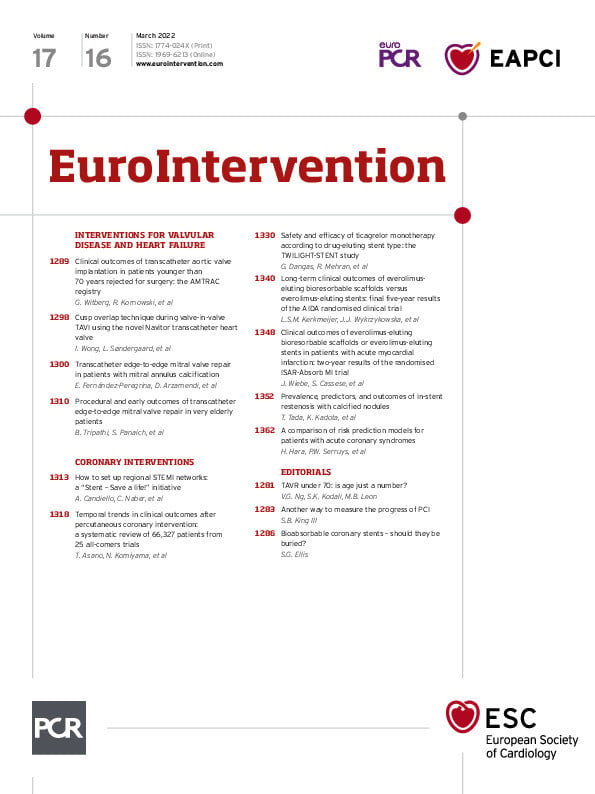Percutaneous coronary intervention (PCI) has come a long way since Herr Bachmann had his left anterior descending artery (LAD) opened by Andreas Gruentzig with balloon angioplasty in 1977. In addition to stenting, many other changes in coronary intervention have occurred in recent years, and the effects of those changes on clinical outcomes have been measured, usually with registry data collected sequentially. We now have another method of assessing changes and outcomes of PCI over time. In this issue of EuroIntervention, Asano et al have used prospective randomised trials performed over different time periods to assess temporal trends in PCI outcomes1. The authors screened appropriate titles and selected “all-comer trials”, comparing one stent to another. Patient-level data was not available, so the outcomes evaluated were those defined as endpoints in the respective trials. Using this methodology, trials initiated in three different time periods (2003-2007, 2008-2012, 2013-2016), were compared. The authors found significant improvement in patients treated in the later trials in: cardiac mortality, target lesion revascularisation (TLR) at 1 year and stent thrombosis at 5 years. There was no improvement in the incidence of myocardial infarction or all-cause mortality. Sensitivity analysis of changes over a 10-year period showed a 31% decrease in 1-year cardiac death and a 34% decrease in 5-year cardiac death. TLR decreased 40% at 1 year, but the difference was no longer significant at 5 years. The most dramatic change over time was the 5-year decrease in stent thrombosis (82%).
Whereas changes in outcomes in more recent trials were influenced by the evolution of PCI technology, these outcomes were also driven by intertrial differences in the definitions and adjudication of events as well as changes in post-PCI medical therapies. Cardiac mortality probably benefitted from improved stenting technology and methodology, and more aggressive medical therapy, but could also have been influenced by the adjudication of cause of death. TLR at 1 year was also probably improved due to better stents and implantation methods but a more liberal use of routine follow-up angiography in the earlier trials was a likely influence as well. By my calculation, the trials with routine follow-up angiography had a 4.2% 1-year TLR rate compared to a 2.4% rate for trials without routine follow-up angiography. It may seem curious that, despite improved stent design, methods of implantation and more powerful antithrombotic agents available in the more recent trials, myocardial infarction (MI) did not improve. As the authors point out, this is likely due to methods of measuring and identifying MI. More liberal definitions, especially since the introduction of troponin measurements, clearly increase the identification of MI in later trials. The improvement in cardiac mortality was not matched by an improvement in all-cause mortality because there were more non-cardiac deaths in the later trials, probably driven by the older age of the trial participants. This explanation still leaves a very important question unanswered: has improved PCI and medical therapy resulted in improved overall survival?
Despite these limitations, the methodology pursued in this study has certain advantages. Baseline and follow-up data are certainly more complete and accurate than registry data. The use of clinical event committees in randomised trials is likely to be superior to data that depends on death certificates. However, having served on several clinical event committees, I can confirm that the identification of cause of death is often not easy. One would like to see the age-adjusted total mortality go in the same direction, over time, as the cardiac mortality, but lacking individual patient data in the current analysis, this was not done.
In addition to sequential registries there are yet other methods to observe temporal changes. Randomised trials comparing revascularisation methods have shown improved outcomes. One example is the comparison of the PCI arm of the SYNTAX trial to the registry of similar patients at a later time point in the SYNTAX II study23. The 1-year mortality of the 3-vessel disease patients in SYNTAX (4.4%) has also been compared to the outcome of those treated in the recent FAME 3 trial (1.6%)4. These intertrial comparisons, of course, have their own limitations. The current study of temporal trends and outcomes of PCI in carefully selected "all-comers trials" is laudable, but we should not minimise the value of observations using other methods. Although the "all-comers trials” included in the current study were those for whom most exclusions to enrolment were eliminated, they were composed of patients who volunteered for randomised trials and did not include all the patients who underwent PCI. Therefore, well-controlled registries with risk adjustment will continue to inform us about temporal trends. We can take some solace in the observation that, despite the methods of measuring trends over time, clinical outcomes seem to have gone in the direction of progress for patients undergoing PCI. As new innovations in percutaneous management of coronary artery disease such as the expansion of intervascular imaging and the assessment of coronary physiology are implemented more widely, as new stents and perhaps bioresorbable devices come into practice, and most importantly, as effective anti-atherosclerotic medical therapies continue to advance, understanding future temporal trends, outcomes and costs will be critical. The use of high-quality data from randomised controlled trials is interesting and will be of even greater value if individual patient data can be used. All methods of judging progress should be explored and prospectively planned.
Conflict of interest statement
The author has no conflicts of interest to declare.
Supplementary data
To read the full content of this article, please download the PDF.

